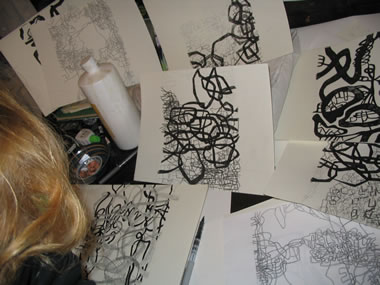
26 AUG 06
How has your first book changed your life?
27. Brenda Iijima

What do you remember about the day when you saw your finished book for the first time?
I don't remember the day in all of its specificity but do remember my impression of seeing 50 copies of Around Sea shrink-wrapped neatly in stacks in the box that arrived. The cover of Around Sea echoes On Bear's Head, a terrific book by Philip Whalen--I was charmed by this slippage of identity. It is a vision of continuity and certainly interconnectivity. Leslie Scalapino, editor of O Books, has linked us inextricably. The colors connote Buddhism. They are tertiary colors, purple and orange. The feeling was and is one of generosity, exuding continually from Leslie's enterprise of ushering books into ecosystems of thought and conscientiousness.

Before that day, did you imagine your life would change because of the book's arrival?
No, not really--not in the sense of an epic transformation happening to me because the work morphed from being a private document into a public one. I'm curious about unintended consequences and experiential particulates that slowly accrue.
How has your life been different since?
My shyness dissolved somewhat--this must be partially related to the book's actuality. Its presence asserted my commitment to publishing others' work--I'm constantly made aware that this experience is an incredible way to learn and to forge relationships. I continue to probe what is book-ness. These pages--leaves--they hold, sustain, offer up. I run Portable Press at Yo-Yo Labs, a micro-press dedicated to the making of chapbooks. As time goes on I see the provocative space that these folders of paper are (meaning the pages). Within the pages of the chapbooks I slip environmental protest letters and other ephemera (sometimes a mini installation of drawings or postcards assembled specifically for the person who'll receive this ecosystem)--additional written documents that impel, relate and agitate in their temporary position lodged there into the body of the book. This is just to say that I become more and more involved with what books might be.
Were you involved in designing the cover of Around Sea?
No. Leslie created the cover design and used a photograph she took in Yemen. While not initially involved, I have taken the liberty to spray paint additional layers on some copies of the book with some furnace paint I found in the cellar. And I also sandpapered a batch, which was a spontaneous and active mark making process. The purple and orange dust was so fine once pulverized--it never landed. The epidermal layer of the book called for interaction. The title, author credit, blurbs, etc., seemed optional--or too heavy there on the surface.
Were there any surprises?
I received a letter from someone I didn't know personally. The letter mapped or scored the entire book in terms of the phonetics.
What did you do to promote the book, and what were those experiences like?
I didn't really do much, or I should say nothing directly. Leslie sent review copies out and thankfully there were responses to the book. I have no idea how many sold, etc.
Can poetry create change in the world?
Definitely. Poetry can be the site of incredible intensity. It embodies and enables awareness. It might involve deep listening, the kind Paulina Oliveros espouses. It agitates centers in the brain that stimulate imagination. Poetry creates a zone of openness--it is capable of moving the mind beyond convention, standardization, pattern and format. Acting in being is how I think of poetry. It is possible to critique cultural, social and historical paradigms via poetry--positions of the body, self, collectivity, gender, race, power, etc. Poetry is language as gesture and can push toward a temporary borderless. Because it is evidence of the reverence for language (which, at its base, is interrelation) it promotes a bounty of energetic exchange between communicants--credulousness in response to incredulousness and all sorts of reflections, deviations, regenerations, etc. Poetry meets up with threatening social issues like war by making its position one of empathy--feelings are conducted, as in electrical flows. At any time, language can extrapolate out of itself (as art, or whatever seemingly limiting condition it finds itself in)--it can become social gesture, action. When I read poetry I hear a call and response.
What influence has the book's publication had on your subsequent writing and other artistic pursuits?
I've been asked to contribute drawings, paintings and photographs for book covers. Book covers are nomadic spaces that transit, interplay. This visual work will always be in relation, crossing over and participating in changeable environments. It is a very agreeable space for how I think and work. It is a thrill to be involved with someone's book in this capacity. A few examples: Kim Lyons' Saline, Anthony Hawley's The Concerto Form, Stacy Szymazek's Emptied of All Ships, Roberto Harrison's Counter Daemons [coming soon from Litmus Press], and Eva Sjödin's Inner China.
As far as the writing goes--it always is mysteriously in conjunction with the visual work I do. They inform each other. E. Tracy Grinnell and Paul Foster Johnson, editors of Litmus Press, are publishing Animate, Inanimate Aims--the book will be out this fall. The text is cocooned or swaddled in a series of drawings and collages. It is a mirror-critique of whiteness and myth, perhaps--and then some (so I hope). Jessica Smith, editor of Outside Voices, is publishing Eco Quarry Bellwether, a text where my objective was to weave sensuality together with pressing political concern. There are four modes within the book.
The work I'm into now deals with phases. Layered inter-textual, multi-tonal visual arrangements are an attempt to orchestrate the work--cause reverberation (relating to bodies) and time dimension variations, etc. Rabbit Lesson, one of these phases, is forthcoming as a chapbook from Fewer & Further Press. Around Sea concerned itself with transitions and systems (interlocking and not).
How do you feel about the critical response to your book and has that had any effect on your writing?
Sarah Porter's review appears in the current issue of How2. It is enlivening to get this unexpected feedback. It is heartening to find that these concerns radiate outward, inward--around. Presently the writing I'm doing comes out of steady research. It is beyond my own (solitary--which is an impossibility anyway) lyrical (romantic) voice. The passion wells up from sources and I respond. The book will be a sort of cacophonous listening chamber. Rhythm is impetus. The content and form of this work is mutable, mutating, regenerative, stained, tainted, visceral and gross. Post-thrash maybe--all about animal, less mineral-based than previous work, though the smattered components of stars do glitter in and amongst animal postures--so it is a vascular, pulsating, decaying, spouting, spawning, oozing continuum of utterance.
It has to do with the illogical separation of humans and animals (in language structures, social structures, historical consideration, etc.). After viewing the documentary film Winter Soldier, I engaged with the modulation of this piece: Remembering Animals. 100 returning Vietnam Vets decided to have their testimonials of witness recorded by a group of filmmakers because they wanted in some way to stop the atrocities being committed. They frankly described their participation in torture. The stark, incredible admission so many soldiers offered had to do with the framework of positioning the "enemy" as an animal and also their "having to become animals" in order to commit these crimes. It seems that this weird dichotomy has much to do with the eco disasters caused by humans, especially in the West, where animals and humans are separated out. I've been doing a lot of research into how animals are portrayed in the visual arts--how humans visualize animals, as well as mutually being animals. The work takes on slavery and that direct dehumanization. As well it forms empathies with animal otherness and is a reflection on hierarchies assumed. And...
Is there something you're doing now that you think will bring about a change that you seek?
Grassroots, hands-on local community efforts interest me greatly and I participate whole-heartedly. I'm involved in environmental activism, peace activism, issues of equality, helping local politicians seeking office, and offshoots from all of this. It feels positive, active, very real, very happening. All of these participations feed another and another. The poetry I write and publish and distribute is connected to these communal interactions and efforts for change and equality. Generosity and energy gets things going. None of this is single-handedly accomplished and this is one aspect of the activist paradigm that feels very holistic and deviant culturally in this land of individual achievement and heroics.
:
from II in Around Sea by Brenda Iijima:
10.
A poem for the land
Corridor after corridor of land
and a pock-marked sky.
The passage is wide
open
to the solar
system.
Still sister
is in arms
spiraling
outward
or inward.
Telling this
is like being
tied to a tree
in the garden.
11.
Our blond hair
binds us now.
The molecules
agitate. Molecule
birdlike.
Heavy-handed
soul
rambling through
the underbrush.
We go, sister and
I sinister since
then when the
leaves hardened
turned silver
in the heat.
Inescapable
Landscape.
12.
Way before hotels
in nearly every travel book
sea salt and sea swells.
Along comes a brave
man against Zeus's
stance checking him
self in.
Checking what the land
was. See to it that
his wants are filled.
Large; variegated buff
brown, purple, and red.
Trumpets, wind.
"Come on
now" murmurs
the seashell. "Come on."
Inevitably.
. . .
next interview: Aimee Nezhukumatathil
. . .
